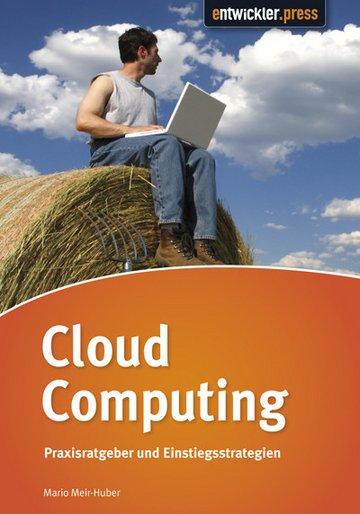| Inhaltsverzeichnis | 4 |
| Vorwort | 8 |
| 1 Einführung in Cloud Computing | 10 |
| 1.1 Was ist Cloud Computing? | 10 |
| 1.2 Cloud Computing – Evolution oder Revolution? | 14 |
| 1.3 Abgrenzung zu anderen Technologien | 18 |
| 2 Technische Grundlagen | 20 |
| 2.1 Datacenter Design | 20 |
| 2.1.1 Virtualisierung | 21 |
| 2.2 REST und SOAP | 22 |
| 2.2.1 REST | 23 |
| 2.3 Architektureinflüsse | 28 |
| 2.3.1 Datenspeicher in der Cloud | 29 |
| 2.3.2 Skalierung | 31 |
| 2.4 Sicherheit in der Cloud | 32 |
| 3 Begrifflichkeiten | 38 |
| 3.1 On-Premise | 38 |
| 3.2 Private, Public und Hybrid Clouds | 39 |
| 3.3 Ebenen des Cloud Computings | 41 |
| 3.3.1 Infrastructure as a Service (IaaS) | 41 |
| 3.3.2 Platform as a Service (PaaS) | 43 |
| 3.3.3 Software as a Service (SaaS) | 45 |
| 3.3.4 Vergleich der Anwendungen | 47 |
| 3.4 Weitere Ansätze | 47 |
| 3.4.1 Software plus Services | 48 |
| 3.4.2 Everything as a Service | 48 |
| 4 Preismodelle und Verträge | 50 |
| 4.1 Service Level Agreements (SLAs) | 50 |
| 4.1.1 Begrifflichkeiten in Service Level Agreements | 52 |
| 4.1.2 Inhalte von SLAs | 52 |
| 4.2 Preismodelle | 54 |
| 5 Was bringt Cloud Computing? | 58 |
| 5.1 Outsourcing als Produktivitätsfaktor? | 58 |
| 5.2 Wann macht es Sinn, Cloud Computing zu verwenden? | 62 |
| 5.3 Kostenbeispiele | 66 |
| 5.3.1 SaaS-Beispiele | 66 |
| 5.3.2 PaaS-Beispiele | 69 |
| 5.3.3 IaaS-Beispiele | 72 |
| 6 Cloud-Computing- Plattformen und -Anbieter | 78 |
| 6.1 Amazon | 78 |
| 6.1.1 Amazon Elastic Compute Cloud (EC2) | 81 |
| 6.1.2 Amazon CloudFront | 90 |
| 6.1.3 Amazon Elastic MapReduce | 91 |
| 6.1.4 Amazon SimpleDB | 92 |
| 6.1.5 Amazon Relational Database Service (Amazon RDS) | 95 |
| 6.1.6 Amazon Simple Storage Service (Amazon S3) | 100 |
| 6.1.7 Amazon Simple Queue Service | 104 |
| 6.1.8 Amazon Mechanical Turk | 109 |
| 6.1.9 Weitere Dienste von Amazon | 112 |
| 6.2 Microsofts Cloud-Computing-Angebote | 117 |
| 6.2.1 Überblick über die Azure-Services-Plattform | 117 |
| 6.2.2 Windows Azure Compute | 118 |
| 6.2.3 Windows Azure Storage | 124 |
| 6.2.4 SQL Azure | 135 |
| 6.2.5 Windows Azure AppFabric | 137 |
| 6.2.6 Microsoft Codename „Dallas“ | 140 |
| 6.2.7 Microsoft BPOS Solutions | 144 |
| 6.3 IBMs Cloud-Computing-Angebote | 145 |
| 6.3.1 IBM Lotus Live | 145 |
| 6.3.2 IBM Smart Business Development and Test | 148 |
| 6.4 Cloud-Computing-Angebote von Google | 150 |
| 6.4.1 Google Apps | 150 |
| 6.4.2 Google App Engine | 153 |
| 6.5 Cloud-Computing-Angebote von SalesForce | 160 |
| 6.5.1 SalesForce Software-as-a-Service-Angebote | 161 |
| 6.5.2 PaaS-Angebote von SalesForce | 167 |
| 6.6 Weitere Cloud-Computing-Anbieter und -Angebote | 174 |
| 6.6.1 Rackspace | 174 |
| 6.6.2 Novell | 177 |
| 6.6.3 Red Hat | 179 |
| 6.6.4 Eucalyptus | 180 |
| 6.6.5 RightScale | 181 |
| 6.6.6 CloudSwitch | 182 |
| 6.6.7 VMware | 183 |
| 6.6.8 Enomaly | 184 |
| 6.6.9 Oracle | 185 |
| 6.6.10 Canonical – Ubuntu | 186 |
| 6.6.11 Fazit | 187 |
| 6.7 Vergleich der Cloud-Computing-Plattformen | 187 |
| 6.7.1 SaaS-Plattformen | 187 |
| 6.7.2 PaaS-Plattformen und IaaS-Plattformen | 189 |
| 6.7.3 PaaS-Plattformen und IaaS-Plattformen | 189 |
| 7 Rechtliche Grundlagen für Cloud Computing | 196 |
| 7.1 Einwirkungen durch das Europäische Datenschutzgesetz | 197 |
| 7.2 Verträge und Servicelevel-Agreements (SLAs) | 204 |
| 7.3 Fazit | 205 |
| 8 Ausblick | 208 |
| 8.1 Die Risiken von Cloud Computing | 208 |
| 8.2 Die Einführung von Cloud Computing in Unternehmen | 212 |
| 8.3 Open-Cloud-Standards? Welche Standards gibt es in der Cloud, werden sich Standards etablieren? | 214 |
| 8.4 Ausblick | 216 |
| Stichwortverzeichnis | 218 |
| A | 218 |
| B | 218 |
| C | 218 |
| D | 218 |
| E | 218 |
| F | 219 |
| G | 219 |
| I | 219 |
| K | 219 |
| L | 219 |
| M | 219 |
| N | 219 |
| O | 219 |
| P | 219 |
| R | 219 |
| S | 220 |
| T | 220 |
| U | 220 |
| V | 220 |
| W | 220 |
| Z | 220 |


















